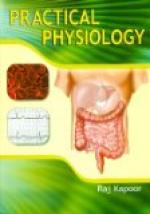[Illustration: Fig. 62.]
Experiment 62. Simple Apparatus for Illustrating Endosmotic Action. “Remove carefully a circular portion, about an inch in diameter, of the shell from one end of an egg, which may be done without injuring the membranes, by cracking the shell in small pieces, which are picked off with forceps. A small glass tube is then introduced through an opening in the shell and membranes of the other end of the egg, and is secured in a vertical position by wax or plaster of Paris, the tube penetrating the yelk. The egg is then placed in a wine-glass partly filled with water. In the course of a few minutes, the water will have penetrated the exposed membrane, and the yelk will rise in the tube.”—Flint’s Human Physiology, page 293.
Experiment 63. Stretch a piece of moist bladder across a glass tube,—a common lamp-chimney will do. Into this put a strong saline solution. Now suspend the tube in a wide mouthed vessel of water. After a short time it will be found that a part of the salt solution has passed through into the water, while a larger amount of water has passed into the tube and raised the height of the liquid within it.
161. The Quantity of Food as Affected by Age. The quantity of food required to keep the body in proper condition is modified to a great extent by circumstances. Age, occupation, place of residence, climate, and season, as well as individual conditions of health and disease, are always important factors in the problem. In youth the body is not only growing, but the tissue changes are active. The restless energy and necessary growth at this time of life cannot be maintained without an abundance of wholesome food. This food supply for young people should be ample enough to answer the demands of their keen appetite and vigorous digestion.
In adult life, when the processes of digestion and assimilation are active, the amount of food may without harm, be in excess of the actual needs of the body. This is true, however, only so long as active muscular exercise is taken.
In advanced life the tissue changes are slow, digestion is less active, and the ability to assimilate food is greatly diminished. Growth has ceased, the energy which induced activity is gone, and the proteids are no longer required to build up worn-out tissues. Hence, as old age approaches, the quantity of nitrogenous foods should be steadily diminished.
Experiment 64. Obtain a sheep’s bladder and pour into it a heavy solution of sugar or some colored simple elixir, found at any drug store. Tie the bladder carefully and place it in a vessel containing water. After a while it will be found that an interchange has occurred, water having passed into the bladder and the water outside having become sweet.
Experiment 65. Make a hole about as big as a five-cent piece in the large end of an egg. That is, break the shell carefully and




